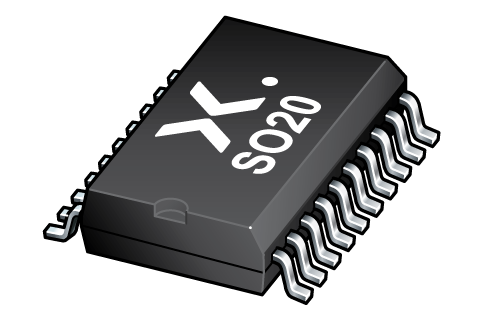Orderable parts
| Type number | Orderable part number | Ordering code (12NC) | Package | Buy from distributors |
|---|---|---|---|---|
| 74LVT2244D | 74LVT2244D,118 | 935217790118 | SOT163-1 | Order product |

Register once, drag and drop ECAD models into your CAD tool and speed up your design.
Click here for more information3.3 V octal buffer/line driver with 30 Ω termination resistors; 3-state
The 74LVT2244 is an 8-bit buffer/line driver with 3-state outputs. The device can be used as two 4-bit buffers or one 8-bit buffer. The device features two output enables (1OE and 2OE), each controlling four of the 3-state outputs. A HIGH on nOE causes the outputs to assume a high-impedance OFF-state. Bus hold data inputs eliminate the need for external pull-up resistors to define unused inputs
The 74LVT2244 is designed with 30 Ω series resistance in both the HIGH and LOW states of the output. This design reduces line noise in applications such as memory address drivers, clock drivers, and bus receivers/transmitters.
Octal bus interface
3-state buffers
Wide supply voltage range from 2.7 V to 3.6 V
Overvoltage tolerant inputs to 5.5 V
BiCMOS high speed and output drive
Output capability: +12 mA and -12 mA
Direct interface with TTL levels
No bus current loading when output is tied to 5 V bus
Bus hold on data inputs
Power-up 3-state
IOFF circuitry provides partial Power-down mode operation
Live insertion and extraction permitted
Latch-up performance exceeds 500 mA per JESD 78 Class II Level B
ESD protection:
HBM: ANSI/ESDA/JEDEC JS-001 class 2 exceeds 2000 V
CDM: ANSI/ESDA/JEDEC JS-002 class C3 exceeds 1000 V
Specified from -40 °C to +85 °C
| Type number | VCC (V) | Logic switching levels | Output drive capability (mA) | fmax (MHz) | Nr of bits | Power dissipation considerations | Tamb (°C) | Rth(j-a) (K/W) | Rth(j-c) (K/W) | Package name |
|---|---|---|---|---|---|---|---|---|---|---|
| 74LVT2244D | 2.7 - 3.6 | TTL | ± 12 | 150 | 8 | medium | -40~85 | 84 | 60 | SO20 |
| Model Name | Description |
|---|---|
|
|
| Type number | Orderable part number, (Ordering code (12NC)) | Status | Marking | Package | Package information | Reflow-/Wave soldering | Packing |
|---|---|---|---|---|---|---|---|
| 74LVT2244D | 74LVT2244D,118 (935217790118) |
Active | 74LVT2244D |

SO20 (SOT163-1) |
SOT163-1 |
WAVE_BG-BD-1
|
SOT163-1_118 |
| Type number | Orderable part number | Chemical content | RoHS | RHF-indicator |
|---|---|---|---|---|
| 74LVT2244D | 74LVT2244D,118 | 74LVT2244D |
|
|
| File name | Title | Type | Date |
|---|---|---|---|
| 74LVT2244 | 3.3 V octal buffer/line driver with 30 Ω termination resistors; 3-state | Data sheet | 2024-07-08 |
| AN90063 | Questions about package outline drawings | Application note | 2025-03-12 |
| SOT163-1 | 3D model for products with SOT163-1 package | Design support | 2020-01-22 |
| lvt2244 | lvt2244 IBIS model | IBIS model | 2013-04-09 |
| Nexperia_package_poster | Nexperia package poster | Leaflet | 2020-05-15 |
| SOT163-1 | plastic, small outline package; 20 leads; 1.27 mm pitch; 12.8 mm x 7.5 mm x 2.65 mm body | Package information | 2024-11-15 |
| SOT163-1_118 | SO20; Reel pack for SMD, 13"; Q1/T1 product orientation | Packing information | 2022-08-01 |
| 74LVT2244D_Nexperia_Product_Reliability | 74LVT2244D Nexperia Product Reliability | Quality document | 2025-03-20 |
| lvt | lvt Spice model | SPICE model | 2013-05-07 |
| WAVE_BG-BD-1 | Wave soldering profile | Wave soldering | 2021-09-08 |
If you are in need of design/technical support, let us know and fill in the answer form we'll get back to you shortly.
The Nexperia Longevity Program is aimed to provide our customers information from time to time about the expected time that our products can be ordered. The NLP is reviewed and updated regularly by our Executive Management Team. View our longevity program here.
| Model Name | Description |
|---|---|
|
|
| Type number | Orderable part number | Ordering code (12NC) | Status | Packing | Packing Quantity | Buy online |
|---|---|---|---|---|---|---|
| 74LVT2244D | 74LVT2244D,118 | 935217790118 | Active | SOT163-1_118 | 2,000 |
|
As a Nexperia customer you can order samples via our sales organization.
If you do not have a direct account with Nexperia our network of global and regional distributors is available and equipped to support you with Nexperia samples. Check out the list of official distributors.
The interactive datasheets are based on the Nexperia MOSFET precision electrothermal models. With our interactive datasheets you can simply specify your own conditions interactively. Start by changing the values of the conditions. You can do this by using the sliders in the condition fields. By dragging the sliders you will see how the MOSFET will perform at the new conditions set.